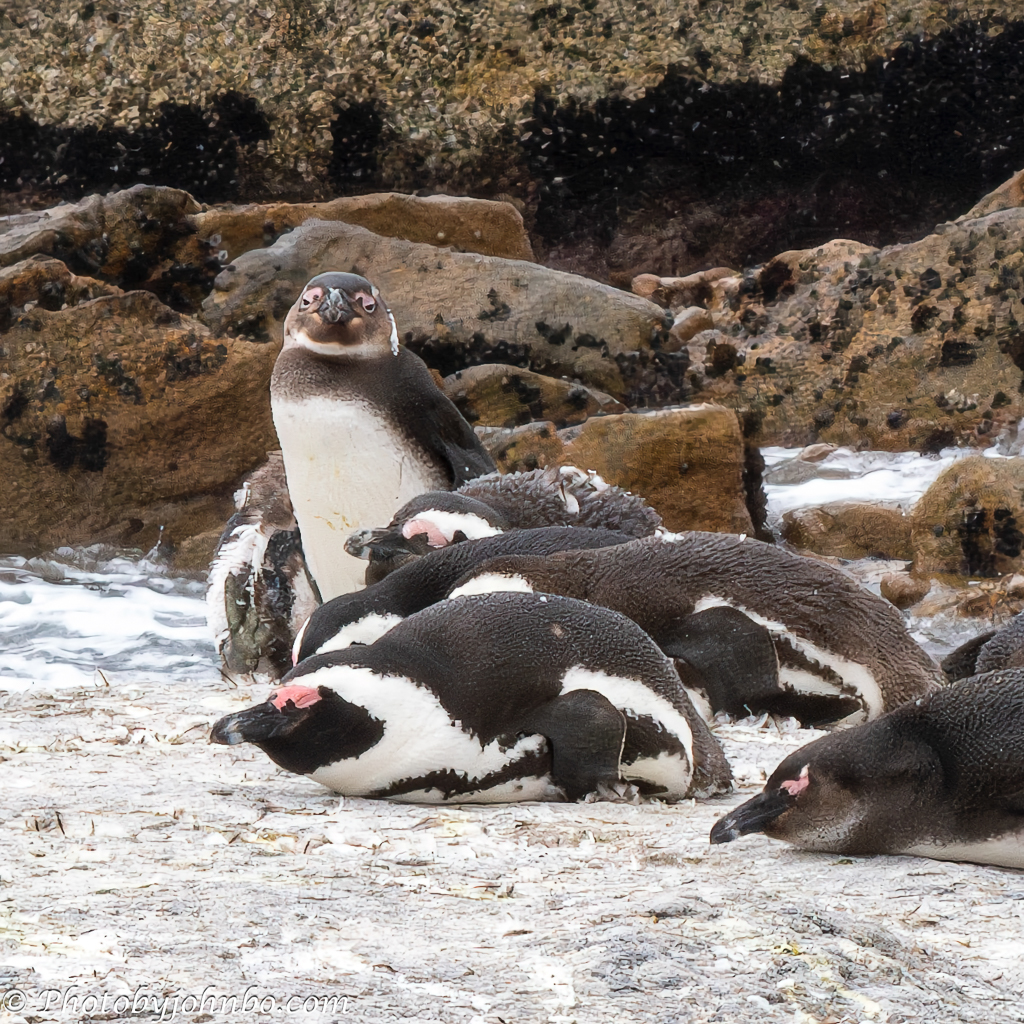
Simon’s Town, South Africa.
Sure, Boulders Beach is an excellent place for swimming. The large boulders act as a windbreak and a natural breakwater, but we came to see the penguins. Besides, the water’s quite cold in the African springtime near the Cape of Good Hope.
A boardwalk provides a raised pathway that winds through the penguin colony area. This keeps visitors on a designated route, preventing them from trampling on nesting sites or getting too close to the penguins. Several viewing platforms and observation decks offer excellent opportunities to see the penguins up close.
Photographers will want to bring longer lenses to photograph these endangered birds. I captured most of these images with my D500 and 200-500 mm lens. In 1983, the first pair of African penguins were sighted on Foxy Beach at Boulders, marking the colony’s beginning.
Having migrated from Dyer Island, these pioneers discovered a haven in False Bay, where a recent ban on commercial fishing had led to a flourishing ecosystem. With ample food and suitable nesting sites readily available, the penguin population at Boulders experienced a rapid surge as they chose this location to raise their families.
However, forty years later, the Boulders Beach penguin population faces significant challenges. Increased human activity, including traffic and competition for breeding sites, has made penguins nest in less secure locations, leaving them vulnerable to predators and the elements. Furthermore, climate change has impacted fish stocks and intensified severe weather events, leading to a decline in penguin chick survival rates.
The penguins were originally called Jackass Penguins due to their distinctive braying calls. Their diet consists primarily of small fish, squid, and crustaceans.
The survival of South Africa’s penguins is threatened by habitat loss, dwindling fish stocks, and increasing human encroachment. Over 60,000 visitors visit Simon’s Town annually to witness and photograph the Boulders Beach penguins. Reference information for this post is found here.
Other wildlife at Boulders Beach includes these cute, rotund mammals. Google tells me that they are closely related to elephants. Visitors to the beach might also see Cape Fur Seals, seagulls, terns, and other coastal birds. That’s another reason to bring your long-focal-length lens.
Built on a rock in False Bay, the Roman Rock Lighthouse is still functional today. Its light was first illuminated in 1861, and the light source was electrified in 1992. More history about the lighthouse visible from Boulders Beach is on Wikipedia here.
Boulders Beach allows visitors to encounter African penguins in their natural habitat. It serves as a reminder of the importance of conservation efforts and the delicate balance between human activity and the preservation of wildlife. Additional images from our visit to Boulders Beach, including this gallery posted in 2K HD, are on my Flickr site here.
John Steiner









Oh, you have made me want May to be here sooner. My tour will be visiting Boulders Beach.
You will enjoy it, for sure, Marie!
When I first started researching for the trip, I was surprised to discover a reference to penguins there. From that point on, I knew it would be a highlight of our Cape Town visit.
These were lovely to see, thanks John
Your dassie made me smile. That’s the Afrikaans name with which they are generally known in South Africa, in English I think they are called rock hyrax. I know about their relatively close relation with elephants, they are actually the closest relatives elephants have. But for the life of me I can’t see it: not just because of size, fur, ears, no tusks, they are also … (sorry) dumb. They’ll eat ANYTHING that is dropped by humans, detremental to their health or not.
They are truly an interesting species, one I didn’t even hear of in my Cape Town research. It’s funny I didn’t notice a mention when reading about Boulders Beach.
Oh, I love penguins, they always make me smile 😀 In fact I have a theory that no one can watch them without smiling! The dassie is interesting too. I’ve also read that they are related to elephants although it seems hard to believe!
I’d seen that reference to elephants as well. It does seem a stretch. >grin<
Great photos and background info John.
Thanks!
This is so fascinating to read, John! I never expected penguins in South Africa, wow! The dassie is intriguing. I read that another mammal is related to elephants too (pecarino?).
I’d have never guessed!
Excellent and informative post. I liked the photos, too, but was surprised that a 300mm lens may not be sufficient.
Well, maybe for me that was the expression of a want rather than a need. >grin<
My niece came up with some nice wildlife pictures with her Nikon zoom that extends to 300 mm, so there’s that. Actually, many of the photos from Boulders Beach were at the 200 mm setting of that lens.
Something very lovable about them, isn’t there?
Indeed!
Educational and well photographed, John. Thanks.
Thank you!
😎
So cute!!
They are, indeed!